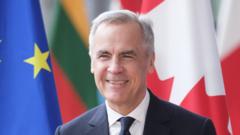Despite robust earnings, the private sector's investment in India has plummeted to a decade low, challenging policymakers to find solutions.
**India's Corporate Investment Dilemma: Record Profits, Yet Stagnant Growth**

**India's Corporate Investment Dilemma: Record Profits, Yet Stagnant Growth**
India's private firms face a paradox of high profits and low investment, raising questions for growth.
India’s private sector is grappling with a remarkable paradox: while corporate profits have reached unprecedented heights, the inclination to invest in new ventures and expansions has significantly dwindled. Recent data reveals that private investment has dropped to its lowest share of gross domestic product (GDP) in ten years, declining to 33% this financial year. This trend has raised alarms among experts who argue that the sustainability of India’s economic growth is at stake.
Historically, private investment in India has seen a downturn since the 2007 global financial crisis, with modest recoveries in recent years being insufficient to spur meaningful capital expenditure. A study involving over 12,500 companies conducted by Icra shows that investments from unlisted firms have, in fact, shrunk, while public companies have also reduced their investment pace.
Concerns have been echoed by prominent figures like banking magnate Uday Kotak, who has cautioned against the decline of entrepreneurial vigor. He encourages successors of family-run businesses to innovate rather than merely manage existing assets. Current financial analysis indicates that non-financial companies are holding cash reserves equivalent to 11% of their total assets, which further illustrates their reluctance to commit funds to active investments.
Multiple factors contribute to this investment stagnation. Weak domestic consumption, sluggish export growth, and stiff competition from affordable Chinese imports are key barriers hindering corporate expansion, as identified by Icra’s Chief Rating Officer, K Ravichandran. Moreover, a decline in private investment has broader implications for India’s economic outlook, with gross fixed capital formation—investment in physical assets—accounting for nearly 30% of the GDP.
The repercussions of this stagnation are evident in India’s expected 6.5% GDP growth, significantly lower than the previous year’s 9.2%. With essential growth drivers such as exports witnessing a slowdown and global uncertainties exacerbated by foreign tariffs, reviving private sector investment becomes crucial for achieving long-term economic objectives.
The World Bank has projected that India will need to amplify its investment levels from 33% to at least 40% of GDP over the next 22 years to fulfill its ambitions of attaining high-income status by 2047. In response, the government has ramped up infrastructure spending, reduced corporate tax rates, and offered substantial production-linked incentives to stimulate growth.
Despite these measures, corporate entities remain hesitant. According to Sajjid Chinoy of JP Morgan, the fundamental issue is a lack of demand that justifies new investments. The post-pandemic economic recovery has been uneven, particularly in urban consumption, which has resulted in companies opting for profitability without expanding their operations.
Rathin Roy, a former member of the Prime Minister's Economic Advisory Council, emphasizes deeper structural issues affecting the investment landscape. He points to a lack of innovation among entrepreneurs and suggests that many business owners have realized they can generate revenue through financial investments rather than traditional business growth.
While the outlook remains uncertain, there may be positive signs ahead. Icra’s recent report highlights potential for increased private sector investment due to projected interest rate cuts and tax relief, although the actual deployment of capital remains to be seen, particularly given the ongoing challenges of global trade conditions.
As India navigates this complex economic terrain, the question remains: will the drive to invest return to revive the nation’s growth trajectory, or will corporations continue to favor managing wealth over generating new opportunities?
Historically, private investment in India has seen a downturn since the 2007 global financial crisis, with modest recoveries in recent years being insufficient to spur meaningful capital expenditure. A study involving over 12,500 companies conducted by Icra shows that investments from unlisted firms have, in fact, shrunk, while public companies have also reduced their investment pace.
Concerns have been echoed by prominent figures like banking magnate Uday Kotak, who has cautioned against the decline of entrepreneurial vigor. He encourages successors of family-run businesses to innovate rather than merely manage existing assets. Current financial analysis indicates that non-financial companies are holding cash reserves equivalent to 11% of their total assets, which further illustrates their reluctance to commit funds to active investments.
Multiple factors contribute to this investment stagnation. Weak domestic consumption, sluggish export growth, and stiff competition from affordable Chinese imports are key barriers hindering corporate expansion, as identified by Icra’s Chief Rating Officer, K Ravichandran. Moreover, a decline in private investment has broader implications for India’s economic outlook, with gross fixed capital formation—investment in physical assets—accounting for nearly 30% of the GDP.
The repercussions of this stagnation are evident in India’s expected 6.5% GDP growth, significantly lower than the previous year’s 9.2%. With essential growth drivers such as exports witnessing a slowdown and global uncertainties exacerbated by foreign tariffs, reviving private sector investment becomes crucial for achieving long-term economic objectives.
The World Bank has projected that India will need to amplify its investment levels from 33% to at least 40% of GDP over the next 22 years to fulfill its ambitions of attaining high-income status by 2047. In response, the government has ramped up infrastructure spending, reduced corporate tax rates, and offered substantial production-linked incentives to stimulate growth.
Despite these measures, corporate entities remain hesitant. According to Sajjid Chinoy of JP Morgan, the fundamental issue is a lack of demand that justifies new investments. The post-pandemic economic recovery has been uneven, particularly in urban consumption, which has resulted in companies opting for profitability without expanding their operations.
Rathin Roy, a former member of the Prime Minister's Economic Advisory Council, emphasizes deeper structural issues affecting the investment landscape. He points to a lack of innovation among entrepreneurs and suggests that many business owners have realized they can generate revenue through financial investments rather than traditional business growth.
While the outlook remains uncertain, there may be positive signs ahead. Icra’s recent report highlights potential for increased private sector investment due to projected interest rate cuts and tax relief, although the actual deployment of capital remains to be seen, particularly given the ongoing challenges of global trade conditions.
As India navigates this complex economic terrain, the question remains: will the drive to invest return to revive the nation’s growth trajectory, or will corporations continue to favor managing wealth over generating new opportunities?




















